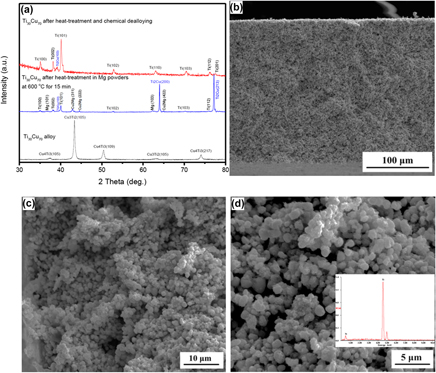Crossref Citations
This article has been cited by the following publications. This list is generated based on data provided by
Crossref.
Zhao, Chonghang
Kisslinger, Kim
Huang, Xiaojing
Lu, Ming
Camino, Fernando
Lin, Cheng-Hung
Yan, Hanfei
Nazaretski, Evgeny
Chu, Yong
Ravel, Bruce
Liu, Mingzhao
and
Chen-Wiegart, Yu-chen Karen
2019.
Bi-continuous pattern formation in thin films via solid-state interfacial dealloying studied by multimodal characterization.
Materials Horizons,
Vol. 6,
Issue. 10,
p.
1991.
Shi, Yao
Lian, Lixian
Liu, Ying
and
Xing, Naiyu
2019.
A novel solid-state dealloying method to prepare ultrafine ligament nanoporous Ti.
Applied Physics A,
Vol. 125,
Issue. 10,
Joo, Soo-Hyun
Wada, Takeshi
and
Kato, Hidemi
2019.
Development of porous FeCo by liquid metal dealloying: Evolution of porous morphology and effect of interaction between ligaments and melt.
Materials & Design,
Vol. 180,
Issue. ,
p.
107908.
Duan, Yalong
Hui, Hongsen
Wang, Hong
Kang, Jianli
and
Li, Jianxin
2019.
Fabrication and characterization of hierarchically porous titanium membrane for dye wastewater treatment.
Materials Research Express,
Vol. 6,
Issue. 11,
p.
115534.
Saba, Farhad
Garmroudi-Nezhad, Elham
Zhang, Faming
and
Wang, Lili
2020.
Fabrication, mechanical property andin vitrobioactivity of hierarchical macro-/micro-/nano-porous titanium and titanium molybdenum alloys.
Journal of Materials Research,
Vol. 35,
Issue. 19,
p.
2597.
Ma, Hailan
Zhao, Bingge
Ding, Kai
Zhang, Yuanheng
Wu, Guanzhi
and
Gao, Yulai
2020.
Influence of dealloying solution on the microstructure of nanoporous copper through chemical dealloying of Al75Cu25ribbons.
Journal of Materials Research,
Vol. 35,
Issue. 19,
p.
2610.
Saldan, Ivan
Orovčik, L’ubomir
Dobrovetska, Oksana
Bilan, Oleh
and
Kuntyi, Orest
2021.
Chemical Leaching of Al3Ni and Al3Ti Alloys at Room Temperature.
Chemistry & Chemical Technology,
Vol. 15,
Issue. 1,
p.
81.
Chuang, A.
Baris, J.
Ott, C.
McCue, I.
and
Erlebacher, J.
2022.
A powder metallurgy approach to liquid metal dealloying with applications in additive manufacturing.
Acta Materialia,
Vol. 238,
Issue. ,
p.
118213.
Zhao, Chonghang
Yu, Lin-Chieh
Kisslinger, Kim
Clark, Charles
Chung, Cheng-Chu
Li, Ruipeng
Fukuto, Masafumi
Lu, Ming
Bai, Jianming
Liu, Xiaoyang
Zhong, Hui
Liu, Mingzhao
Ghose, Sanjit
and
Chen-Wiegart, Yu-chen Karen
2023.
Kinetics and evolution of solid-state metal dealloying in thin films with multimodal analysis.
Acta Materialia,
Vol. 242,
Issue. ,
p.
118433.
Salverda, Allison
Abner, Sharon
Mena-Morcillo, Emmanuel
Zimmer, Adam
Elsayed, Abdallah
and
Chen, Aicheng
2023.
Electrochemical, Scanning Electrochemical Microscopic, and In Situ Electrochemical Fourier Transform Infrared Studies of CO2 Reduction at Porous Copper Surfaces.
The Journal of Physical Chemistry C,
Vol. 127,
Issue. 15,
p.
7151.
Tappan, Bryce C.
2023.
Springer Handbook of Aerogels.
p.
1129.
Wang, Hong
Wang, Bing
Liu, Zhanqiang
Zhao, Jinfu
and
Zhang, Haiming
2023.
Microstructure and mechanical properties of NiTi nanoporous structures fabricated with dealloying process.
Journal of Alloys and Compounds,
Vol. 933,
Issue. ,
p.
167804.
Yang, Xiao-Li
Du, Xian-Feng
Xu, Zhi-Lin
Liang, Zhong-Shuai
and
Xiong, Li-Long
2024.
Progress in processing of porous titanium: a review.
Rare Metals,
Vol. 43,
Issue. 5,
p.
1932.
Gao, Qiang
Ye, Bing
Huang, Wei
Zhou, Fei
and
Zhou, Zhifeng
2025.
Fabrication and structure evolution of porous copper via one-step dealloying of H62 copper-zinc alloy.
Journal of Alloys and Compounds,
Vol. 1014,
Issue. ,
p.
178796.
